Sanok- Subcarpathian 作者: 来源: 发布时间:2021-10-22
Ⅰ. Population and Area
Population (2016)
• Total 38,397
Area
• Total 38.15 km2 (14.73 sq mi)
Website http://www.sanok.pl
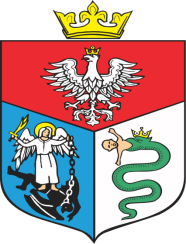
Ⅱ.Natural Geography (environment and resources)
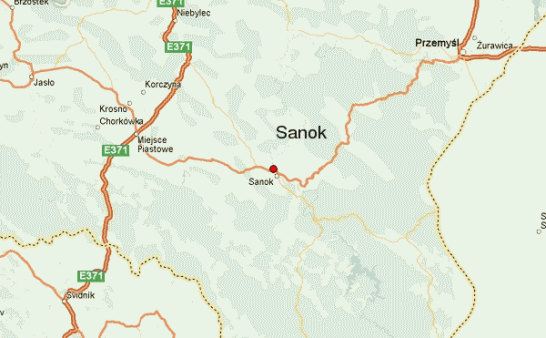
-It is the capital of Sanok County in the Subcarpathian Voivodeship. Previously, it was in the Krosno Voivodeship (1975–1998) and in the Ruthenian Voivodeship (1340–1772), which was part of Red Ruthenia and, in wider sense, of the Lesser Poland Province of the Polish Crown (not of Lesser Poland proper). Historically it was part of the Land of Sanok and the Ruthenian Voivodeship.
-This historic city is situated on the San River at the foot of Castle Hill in the Lesser Poland (Małopolska) region. It lies in a wooded, hilly area near the national road number 28, which runs along southern Poland, from Ustrzyki Dolne to Wadowice (340 km or 211 mi away). It is located in the heartland of the Pogórze Bukowskie part of Doły (Pits), and its average elevation is 300 m (984 ft) above sea level, although there are some hills located within the confines of the city.
-Sanok is located on the bank of the river San. The area surrounding mountain range stretches between the Wisłok, Osława and San Rivers in the Salt Mountains (Central Beskidian Piedmont), in the inland with temperateness climate. The hills of the Bieszczady mountain range are typical for this countryside. Sanok County is bordered by Krosno County to the west, Brzozów County to the north, Przemyśl County to the north-east and Lesko County to the east. It also borders Slovakia to the south. Before World War II, the Oslawa and San Rivers line was designated the wild frontier between Poles and Lemkos.
-Transport
-The closest major airport to Sanok, Poland is Rzeszów-Jasionka Airport (RZE / EPRZ). This airport is in Rzeszow, Poland and is 89 km from the center of Sanok, Poland.
-Sanok – Airports nearby
-Rzeszów–Jasionka Airport (39.2 miles / 63.1 kilometers)
-Uzhhorod International Airport (63.8 miles / 102.7 kilometers)
-Košice International Airport (75.6 miles / 121.7 kilometers)
-Lviv Danylo Halytskyi International Airport (80.3 miles / 129.3 kilometers)
Ⅲ.Economy
-Sanok has a strong industry base - home to Stomil Sanok (established in 1932) and Pass Gummiwerke plants, producers of various rubber and metal-rubber seals, strings and laggings for automotive sector, construction industries and electrical household goods sector, PGNiG and Sanok Bus Car Factory "Autosan" (established in 1832), a producer of high capacity buses, cabins for the Polish Army and bodies for rail-vehicles. Stomil is next to the main train station in Sanok and Autosan is a 10-minute walk from the station, while the town centre is a 15-minute walk in the other direction.
-Sanok - Wikipedia https://en.wikipedia.org/wiki/Sanok#Economy
-In 2017, in the Sanok commune, 996 entities of the national economy were registered in the REGON register, 800 of which were natural persons conducting business activity. That year, 114 new entities were registered, and 74 entities were deregistered. Over the years 2009-2017, the most (115) entities were registered in 2014, and the least (81) in 2011. In the same period, most (112) entities were removed from the REGON register in 2011, while the least (37) entities were deregistered in 2010. According to the data from the REGON register, the largest number of entities with legal personality in the Sanok commune (35) are limited liability commercial companies. When analyzing the register in terms of the number of employees, it can be concluded that the most (975) are micro-enterprises, with 0 - 9 employees. 5.4% (54) entities declared agriculture, forestry, hunting and fishing as their type of activity, 27.0% (269) entities declared their type of activity as industry and construction, and 67.6% (673) entities in the register are qualified as other activity. Among the natural persons running a business in the Sanok commune, the most frequently declared types of activity are Wholesale and retail trade; repair of motor vehicles, including motorcycles (26.3%) and Construction (21.0%). Among the natural persons running a business in the Sanok commune, the most frequently declared types of activity are Wholesale and retail trade; repair of motor vehicles, including motorcycles (26.3%) and Construction (21.0%). Among the natural persons running a business in the Sanok commune, the most frequently declared types of activity are Wholesale and retail trade; repair of motor vehicles, including motorcycles (26.3%) and Construction (21.0%).
-More: https://www.polskawliczbach.pl/gmina_Sanok
Ⅳ.Industrial Characteristics
-The most important sectors of the economy represented in the city: automotive, chemical industry, food industry, construction, household appliances, oil and gas mining, interior furnishings, glass and other industries.
-Economy «Official website of the City of Sanok http://www.sanok.pl/gospodarka/
-Key projects
-1. "Family 500+" program
-In order to be entitled to the 500+ benefit under the new rules, i.e. from July 1, the parent of the child for whom the benefit is not currently paid, must submit an application in the period from July 1, 2019 to September 30, 2019. This means that only the submission of the application by the end of September 2019 guarantees that such parent that the childcare benefit under the new rules will be paid with the compensation from July.
-"Family 500+" program «Official website of the City of Sanok http://www.sanok.pl/program-rodzina-500/
-2. Update of the Local Program for the Revitalization of the City of Sanok for 2016-2022
-Ladies and Gentlemen, The Mayor of the City of Sanok encourages residents of the City of Sanok, enterprises and non-governmental organizations to submit regeneration projects that fit in into the revitalization process, which in the next stage of revitalization program update will be verified in terms of compliance with the program objectives, feasibility and impact on the elimination or reduction of negative phenomena in the city. If the above conditions are met, they will be entered on the list of planned basic projects or included in the characteristics of other acceptable revitalization projects in the revitalization program.
-Revitalization is a broad process of social, spatial and economic changes in an area that is in crisis. Its purpose is to revive the degraded parts of the city and supplement them with new functions.
-At the present stage, work is underway to designate degraded areas and revitalization areas. The planned date of publication of the draft document is February 20, 2017.
-If you are interested, we encourage you to submit task proposals by filling out the form
-In particular, please indicate projects that will help solve social problems,
-including in particular those related to:
-reconstruction, expansion, modernization and adaptation of infrastructure facilities
-for social purposes, including:
-facilities offering daytime support for children and youth (e.g. nurseries, kindergartens and other forms of pre-school education, schools, community centers, including community centers),
-recreational facilities (e.g. health paths, playgrounds, sports fields),
-facilities where services are provided for the social and professional activation of residents,
-multifunctional facilities in which various social functions are combined;
-construction, reconstruction, expansion, modernization and adaptation of cultural infrastructure facilities;
-activities leading to the economic recovery of the revitalized areas (e.g. development of space for economic purposes);
-development (reconstruction, extension, modernization and adaptation) of public space for social purposes (e.g. squares, squares, parks);
-modernization and renovation of public utility buildings improving their external aesthetics;
-modernization and renovation of common parts of multi-family residential buildings, i.e. renovation of structural elements of the building (roofs, facades, facade windows and doors, staircases and corridors).
-"soft" projects aimed at the local community, e.g .:
-advisory and training support in the field of creating and running social enterprises, including social cooperatives;
-organization of projects integrating and activating the local community;
-organization of workshops, courses, individual and group training to counteract social exclusion;
-organization of activities for children and youth living in crisis areas, aimed at equalizing educational opportunities for students and developing their interests.
-All fields of the form should be filled in (legible / computer) and after signing, the original should be submitted to the administration office of the City Hall, Rynek 1, or send the completed form in electronic form to the following address: Rozwoju@um.sanok.pl in the title, please include: Application for Revitalization Project.
-We are waiting for the completed forms until February 13, 2017
-We are planning public consultations on the project of the Local Revitalization Program for the City of Sanok for 2016-2022 in the second half of February, about which we will keep you informed.
-We encourage you to co-create the revitalization program and joint activities to improve the quality of life in the City of Sanok.
-"Update of the Local Revitalization Program for the City of Sanok for 2016-2022", a document co-financed by the European Union, the Cohesion Fund under the Operational Program Technical Assistance 2014-2020 and the state budget.
-Update of the Local Revitalization Program for the City of Sanok for the years 2016-2022 «The official website of the City of Sanok http://www.sanok.pl/aktualizacja-lokalnego-programu-rewitalizacji-miasta-sanoka-na-lata-2016-2022/
Ⅴ.Attrations and Cityscape
-Skansen in Sanok - detailed houses, churches, cerkiews (Orthodox/Uniate churches of Lemkos, Boykos etc.)
-Sanok castle and Icon collection - one of the largest collections of this in Central and Eastern Europe.
-Town square/Rynek
-Parish Church dating to the 19th century
-Franciscan Church dating to the 14th century.
-Near the central town square and the previous Jewish ghetto, there is a valley where much of the Jewish population was murdered en masse by the Nazis during the Holocaust.
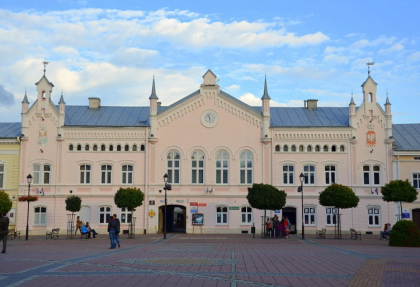
Neogothic town hall
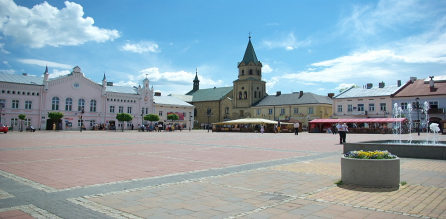
Main Market Square in Sanok
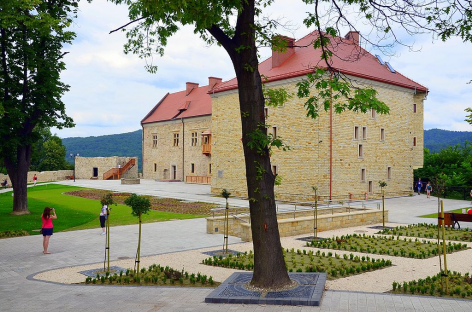
Sanok Castle
Ⅵ.History and Culture
-In 981 the gord, then inhabited by the Slavic tribe of Lendians, was made a part of Land of Czerwień. This area was mentioned for the first time in 981, when Vladimir I of Kiev took the area over on the way into Poland. In 1018 it returned to Poland, 1031 back to Rus', in 1340 Casimir III of Poland recovered it. The gord of Sanok in mentioned for the first time in Hypatian Codex in 1150. It was given the Magdeburg law by Boleslaw-Yuri II of Galicia in 1339.
-In a Ruthenian chronicle can be found the Hypatian Codex, where at the date of 1150 one can read: The Hungarian King Géza II of Hungary crossed the mountains and seized the stronghold of Sanok with its governor as well as many villages in the Przemyśl area. The same chronicle refers to Sanok twice more, stating that in 1205 it was the meeting place of a Ruthenian princess Anna and a Hungarian king and that in 1231 a Ruthenian prince made an expedition to "Sanok - Hungarian Gate".
-After 1339 Galicia–Volhynia was seized by King Casimir III of Poland, who reconfirmed the municipal status of Sanok on 25 April 1366. At that time Sanok became the centre of a new administrative district called Sanok Land, a part of the Ruthenian Voivodeship. Several courts of justice operated in the town, including the municipal and rural courts of lower instance and also the higher instance court for the entire Sanok Land, based on the German town law. Germans settled in the territory of the Kingdom of Poland (territory of present-day Subcarpathian Voivodeship) from the 14th to 16th centuries (see Ostsiedlung), mostly after the region returned to Polish sphere of influence in 1340, when Casimir III of Poland took the Czerwień towns.
-Neogothic town hall
-Marcin Bielski states that Bolesław I the Brave had settled some Germans in the region to defend the borders against Hungary and Kievan Rus', who later turned to farming. Maciej Stryjkowski mentions German peasants near Przeworsk, Przemyśl, Sanok, and Jarosław, describing them as good farmers. The region was also traditionally inhabited by subgroups of the Rusyn people: Lemkos and Boykos.
-As early at the 17th century, an important trade route went across Sanok connecting the interior of Hungary with Poland through the Łupków Pass. As a result of the first of Partitions of Poland (Treaty of St-Petersburg dated 5 July 1772, Sanok was attributed to the Habsburg Monarchy. At that time the area (including west and east of Subcarpathian Voivodship) was known as the Galicia province. For more details, see the article Kingdom of Galicia and Lodomeria.
-In the mid-18th century, 47.7% of the town's population was Roman Catholic (Polish), 36.4% Jewish, and 14.7% Greek Catholic (Ruthenian).
-The Galician peasant revolt took place in the region during the revolutions of 1848.
-The course of the river Dunajec and that of the San, both in West Galicia, marked the two successive stages in the breakthrough battle which initiated the Austro-German offensive of 1915 on the eastern front. An attempt to hold the line of the Wisłok river and the Łupków Pass failed before renewed Austro-German attacks on 8 May 1915. Wisłok Valley was one of the strategically important Carpathian rivers bitterly contested in battles on the Eastern Front of World War I during the winter of 1914–1915.
-Main Market Square in Sanok
-During World War I, the Russian army occupied the town from May until July, 1915 and significantly damaged the town.[according to whom?] The town was subsequently occupied by troops of the Austro-Hungarian Empire.
-Sanok Castle
-During the Second Polish Republic (1919–1939), Sanok was known as a centre of Ukrainian movement in Galicia, and of cultural heritage of the Lemkos and other Rusyns.
-The Jewish population of Sanok may have been almost 30% for many years in the early 20th century. At the beginning of the Nazi occupation, the Jewish population was around 5000. With the advent of the Nazis and with anti-semitism in Galicia, most of the Jews were either executed or killed in Nazi death camps or Nazi concentration camps during the Holocaust. Some of the actions against the Jews were assisted by Ukrainian auxiliaries and hundreds of the deaths occurred in Sanok itself. Buildings that had been owned by Jews were taken by the local population. The local Jewish cemetery still exists. Several hundred Jews are thought to have survived, most of whom fled to the Soviet Union at the beginning of the war. Some of the Jews emigrated to Canada and the United States in the early 1900s with Sanoker Burial Societies spreading throughout New York and other regions where they settled.
-In 1943 the foundation of the Waffen-SS Division Galizien took place in heavily Ukrainian-populated Sanok, with many locals volunteering in the ethnic Ukrainian Waffen-SS. Because of material support and assistance provided by the local population to the Ukrainian Insurgent Army, which was waging a battle for Ukrainian separatism against the Polish state, Polish authorities deported the Ukrainian and Lemko population of Sanok and its region to the former eastern territories of Germany attached to Poland after World War II (the so-called Recovered Territories) during Operation Vistula (1946–1947). Some the Lemkos expelled returned to Sanok in 1957-58 and others after 1989.
-Sanok contains an open-air museum called a skansen in the Biała Góra district, where examples of architecture from all of the region's main ethnic groups have been moved and carefully reassembled in a skansen evoking everyday rural life in the 19th century.
Ⅶ.Other Information
-Sanok [ˈsanɔk] (in full the Royal Free City of Sanok - Polish: Królewskie Wolne Miasto Sanok, Ukrainian: Cянік Sianik, Latin: Sanocum, Yiddish: סאניק, Sonik) is a town in the Subcarpathian Voivodeship of south-eastern Poland with 38,397 inhabitants, as of June 2016. Located on the San River and around 52 km south of Przemyśl, Sanok lies directly by the Carpathian Mountains.
-Once settled by Poles, Jews and Lemkos, the town's history goes back almost 1000 years when it was part of a medieval trade route. The Museum of Folk Architecture as well as the refurbished Sanok Castle and Old Town are popular points of interest. The region also features a 70 km trail for hikers and cyclists.
Ⅷ.Contact Information
Mayor Tomasz Matuszewski
-Tel (13) 46 - 52 - 811 (centrala)
-Fax. (13) 46 - 308 - 90
-Email: sekretariat@um.sanok.pl
